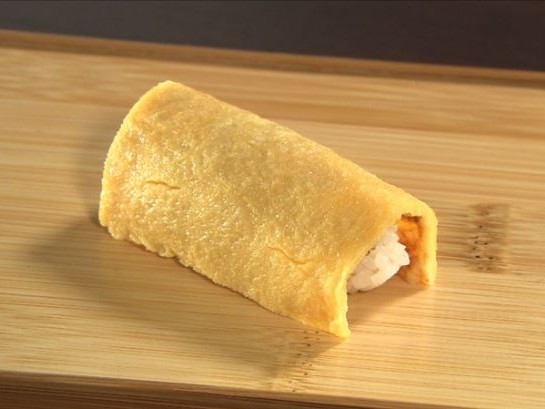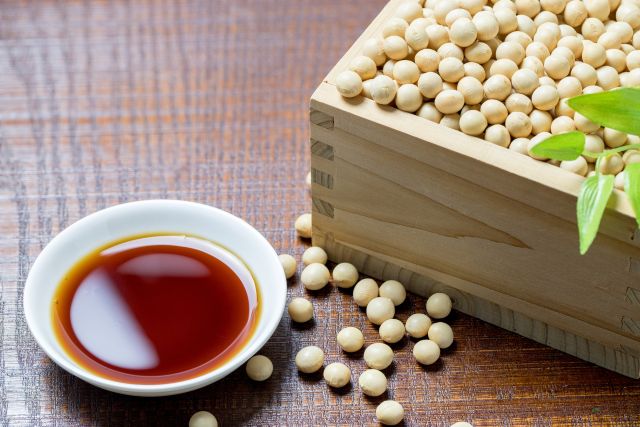
The Deliciousness of Nigiri Sushi and the Role of Soy Sauce
The appeal of nigiri sushi lies in the balance between the vinegared rice
’s gentle acidity and the seafood’s natural umami. Soy sauce elevates this harmony, acting like a quiet but essential partner in the background—a supporting role without which sushi would feel incomplete.
So-called Kansai-style sushi, such as oshizushi, bozushi, and hakozushi, which developed from preserved foods, involves seasoning not only the vinegared rice but also the sushi toppings. Therefore, it can be eaten without soy sauce. However, Edomae sushi uses fresh ingredients and values the inherent flavor of those ingredients. This necessitated a soy sauce that wouldn’t compromise the natural taste of the ingredients but rather enhance it.
Soy sauce contributes more than taste. It also helps neutralize the fishy odor that vinegar alone cannot remove. For instance, in hikarimono like kohada, saba, and aji, even a light brush of soy sauce softens the smell and polishes the flavor.
Beyond flavor and aroma, soy sauce also plays a role in preservation. Just as vinegar and salt protect sushi from spoilage, soy sauce has long been recognized for its bacteriostatic properties. In this way, it supported the development of Japanese cuisine, which relies on raw ingredients even in Japan’s humid climate.
Whether through its color, taste, fragrance, or hygienic qualities, soy sauce is woven into the very foundation of Japanese culinary culture.
Traditional Soy Sauce in Edomae Sushi
Edomae sushi originally used seafood caught in Tokyo Bay, but from the Edo period onward, fish such as tuna were also brought in from distant waters. These were often marinated in soy sauce in a technique called zuke. The name itself comes from this marinade, and to this day, sushi shops that uphold Edomae traditions still serve maguro zuke. Thanks to modern freezing and storage methods, fresh tuna is available year-round, so zuke is no longer a necessity—but its deep, mellow flavor endures.
In the past, soy sauce was rougher and less refined than today. To suit their needs, sushi chefs would cook and season it, creating nikiri shoyu (“simmered soy sauce”). This is typically made by gently simmering soy sauce with 10–20% mirin, sometimes with sake, bonito stock, or water. After about 30 minutes, when bubbles form, the heat is turned off. The word nikiri—literally “simmered to completion”—is said to come from this step.
Although improvements in modern soy sauce mean some shops no longer use nikiri, many traditional Edomae sushi restaurants still brush it onto their nigiri, just as they continue the practice of zuke.
Among simmered toppings (nimono) like anago, shako, and hamaguri, another essential sauce is tsume (or nitsume). Made by reducing the simmering liquid of anago or hamaguri with soy sauce, mirin, and sugar until it becomes a rich glaze—about one-tenth its original volume—tsume has been perfected in each restaurant’s own style.
Traditionally, tsume is prepared when high-quality anago arrives. The head and bones are simmered to create a flavorful broth, which is strained and then combined with soy sauce, mirin, and sugar. It is slowly reduced over half a day into a glossy sauce. The choice of soy sauce here is critical, and many sushi chefs say that the depth of a restaurant’s tsume reflects its true character.
Conclusion
In sushi, soy sauce is far more than a condiment. It balances flavors, refines aromas, preserves freshness, and embodies tradition. The delicate ways in which it is used—through zuke, nikiri, or tsume—are a testament to the craft of Edomae sushi and remain central to the essence of sushi culture today.
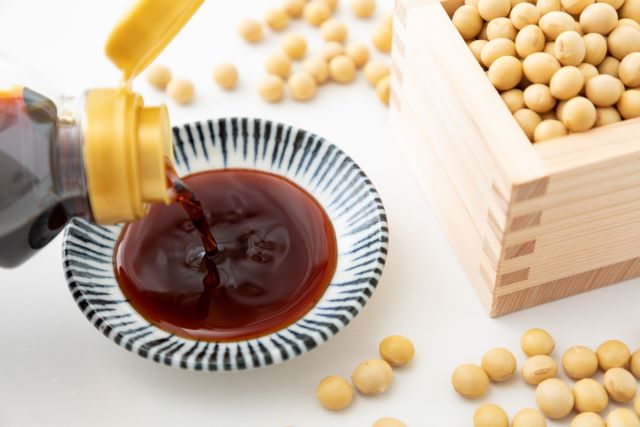
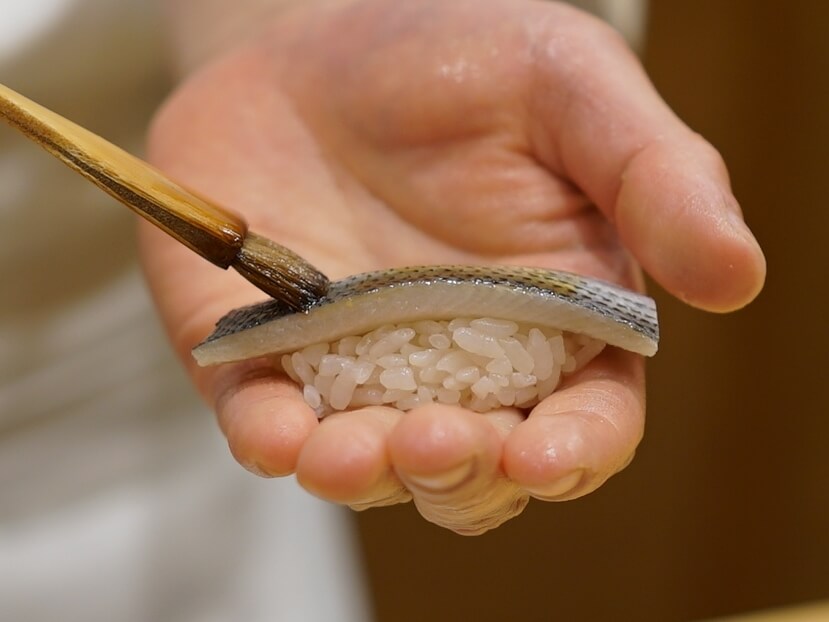 At high-class restaurants, the minimum required nikiri soy sauce is brushed on to the piece, but at restaurants frequented by the general public, customers dip their sushi in as much sauce (soy sauce that includes chemical seasonings) as they like. In fact, there is a gimmick here. The high-class restaurant provides an opportunity for their customers to eat sushi toppings in the most delicious state possible, but the restaurants for the general population allow customers to eat casually with sauce, a daily necessity. This changes how topping ingredients are selected. If the sushi is going to be dunked into the soy sauce, then the topping must have an appropriate fat content that won’t be overpowered by the soy sauce. Therefore, instead of a coastal tuna, a farm-fattened tuna with oily fat is preferred. It is often said that farm-fattened products are too rich, but it is also said that they have an impact that isn’t overpowered by the sauce they are enjoyed with.
At high-class restaurants, the minimum required nikiri soy sauce is brushed on to the piece, but at restaurants frequented by the general public, customers dip their sushi in as much sauce (soy sauce that includes chemical seasonings) as they like. In fact, there is a gimmick here. The high-class restaurant provides an opportunity for their customers to eat sushi toppings in the most delicious state possible, but the restaurants for the general population allow customers to eat casually with sauce, a daily necessity. This changes how topping ingredients are selected. If the sushi is going to be dunked into the soy sauce, then the topping must have an appropriate fat content that won’t be overpowered by the soy sauce. Therefore, instead of a coastal tuna, a farm-fattened tuna with oily fat is preferred. It is often said that farm-fattened products are too rich, but it is also said that they have an impact that isn’t overpowered by the sauce they are enjoyed with.
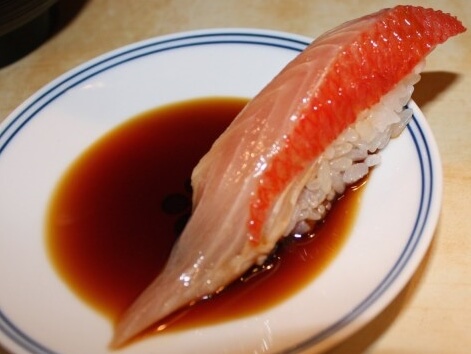 There is a sensor on the tongue that feels the degree of saltiness. This prevents us from eating too much of things that are extremely salty. Chemical seasonings confuse that sensor. The chemical seasoning palliates the degree of saltiness felt by the tongue. Even if you were to, for example, dunk your sushi into the soy sauce and chemical seasoning mixture, it won’t feel salty. If you eat sushi with the sauce, you can take in a high volume of sodium, which is a pleasure trigger for the human body, without feeling the saltiness on your tongue. In other words, it may be more accurate to say that with commoner sushi, you actually drink the sauce, not dip into it.
There is a sensor on the tongue that feels the degree of saltiness. This prevents us from eating too much of things that are extremely salty. Chemical seasonings confuse that sensor. The chemical seasoning palliates the degree of saltiness felt by the tongue. Even if you were to, for example, dunk your sushi into the soy sauce and chemical seasoning mixture, it won’t feel salty. If you eat sushi with the sauce, you can take in a high volume of sodium, which is a pleasure trigger for the human body, without feeling the saltiness on your tongue. In other words, it may be more accurate to say that with commoner sushi, you actually drink the sauce, not dip into it.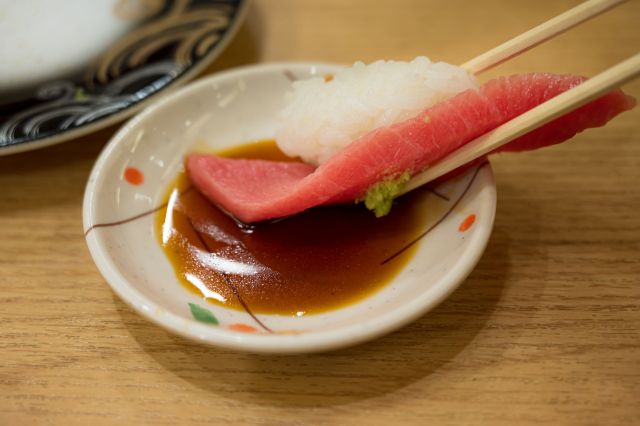

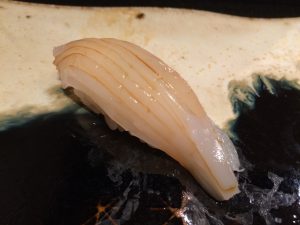 First of all, lightly applying just a small amount of Nikiri shoyu (sushi sauce) on the sushi topping brings out its natural umami flavor and also creates an attractive glossy glaze. Scientifically, this technique leverages the odor-masking properties of soy sauce, which contains sulfur-containing compounds such as methanethiol (methyl mercaptan). These compounds chemically interact with and neutralize unpleasant raw fish odors, effectively masking the “fishy” smell and enhancing the overall sensory experience.
First of all, lightly applying just a small amount of Nikiri shoyu (sushi sauce) on the sushi topping brings out its natural umami flavor and also creates an attractive glossy glaze. Scientifically, this technique leverages the odor-masking properties of soy sauce, which contains sulfur-containing compounds such as methanethiol (methyl mercaptan). These compounds chemically interact with and neutralize unpleasant raw fish odors, effectively masking the “fishy” smell and enhancing the overall sensory experience.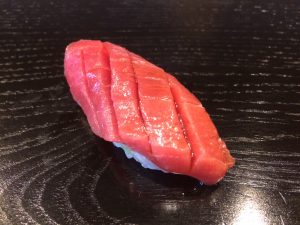 Historically, zuke (soaking fish in nikiri soy sauce) was not limited to tuna but applied to other types of fish as well. This traditional method takes advantage of the bacteriostatic effects of soy sauce—its high salt concentration and presence of antimicrobial peptides inhibit the growth of harmful bacteria like
Historically, zuke (soaking fish in nikiri soy sauce) was not limited to tuna but applied to other types of fish as well. This traditional method takes advantage of the bacteriostatic effects of soy sauce—its high salt concentration and presence of antimicrobial peptides inhibit the growth of harmful bacteria like 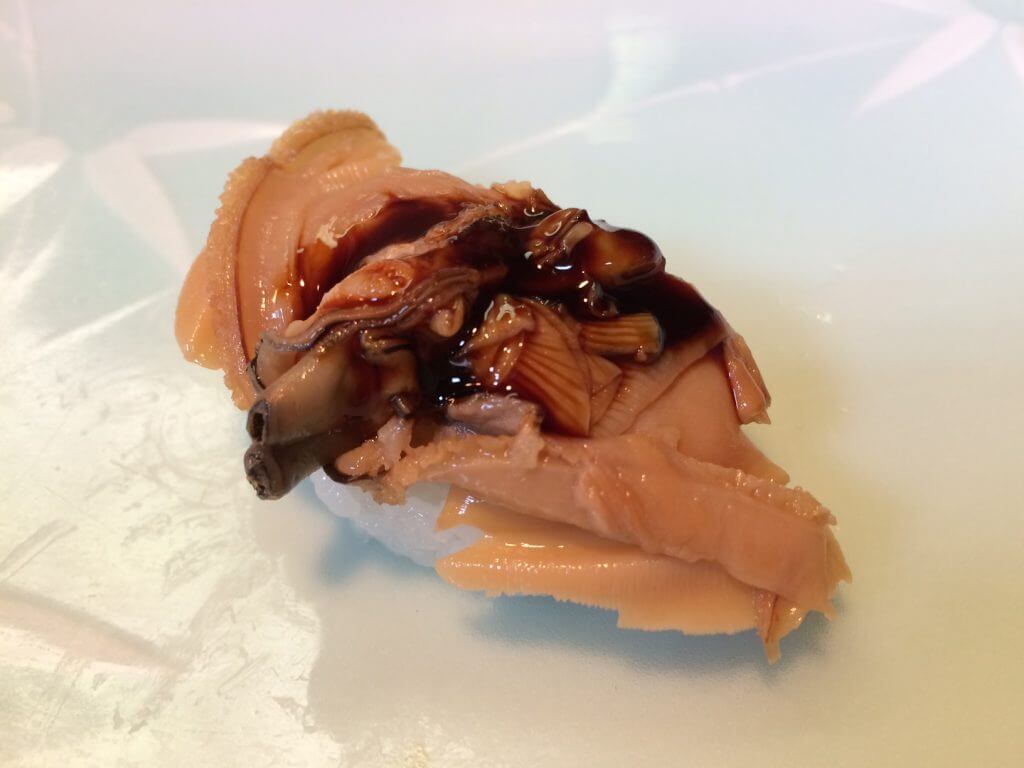 Tsume, a thickened sushi sauce made by boiling down soy sauce with simmered conger eel sauce, mirin and sugar, demonstrates the thermal chemical reactions involved in soy sauce cooking. The Maillard reaction between amino acids from the soy sauce and reducing sugars creates a rich brown glaze and complex aroma that stimulates appetite. This reaction also contributes to the development of subtle caramelized flavors, enhancing the sauce’s depth.
Tsume, a thickened sushi sauce made by boiling down soy sauce with simmered conger eel sauce, mirin and sugar, demonstrates the thermal chemical reactions involved in soy sauce cooking. The Maillard reaction between amino acids from the soy sauce and reducing sugars creates a rich brown glaze and complex aroma that stimulates appetite. This reaction also contributes to the development of subtle caramelized flavors, enhancing the sauce’s depth.